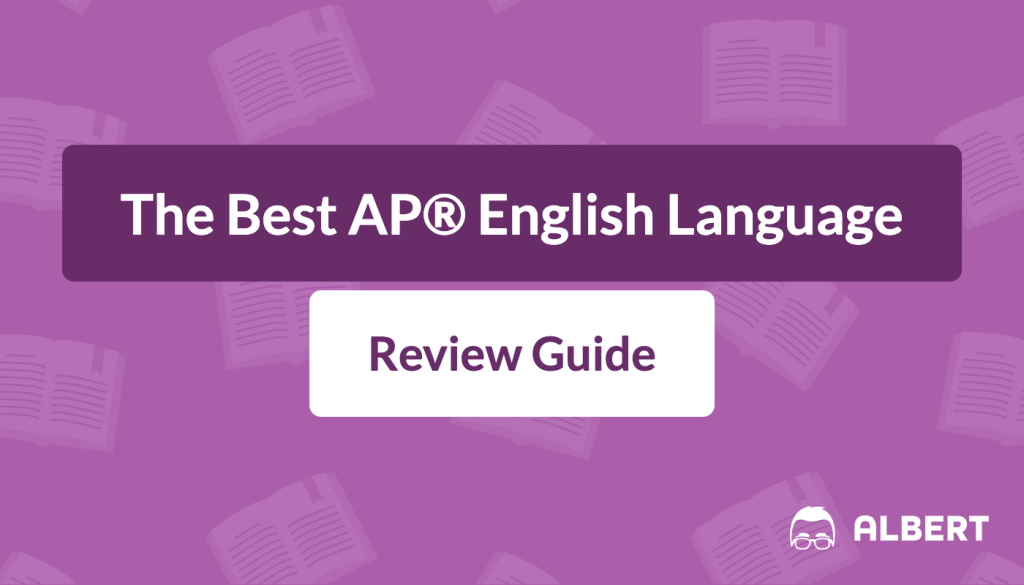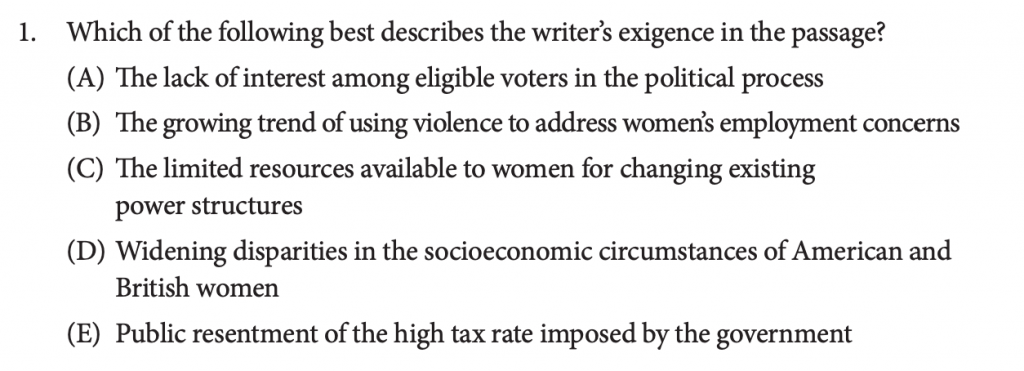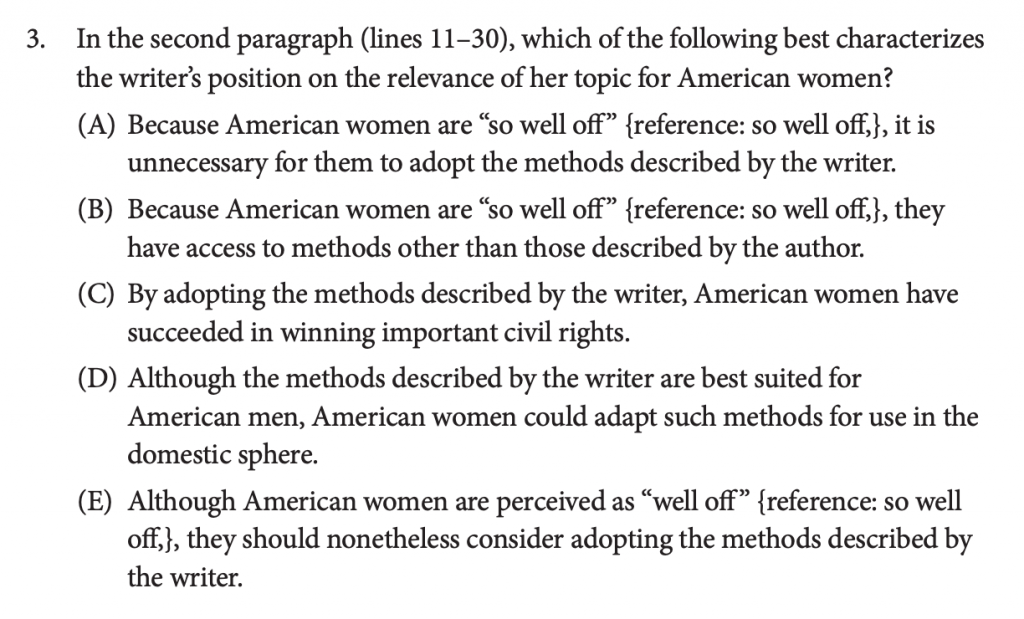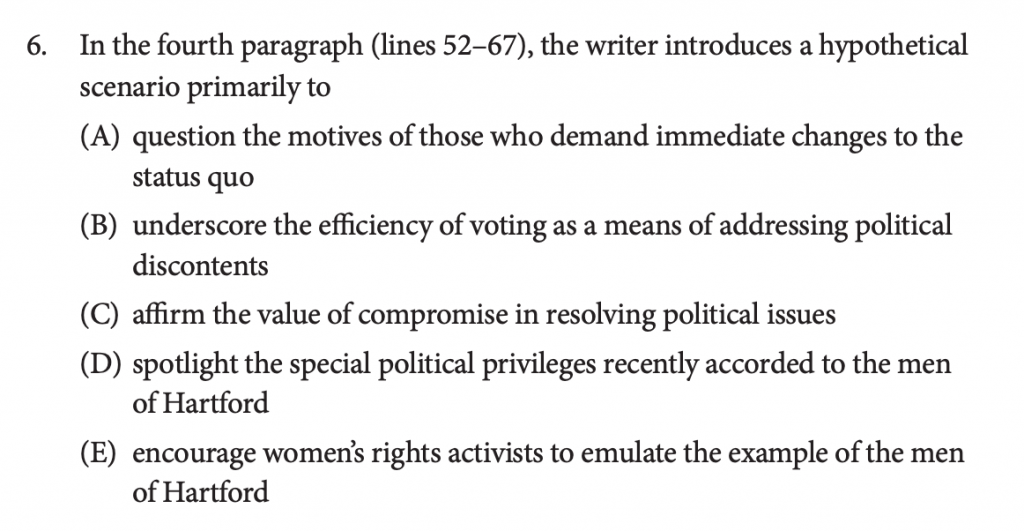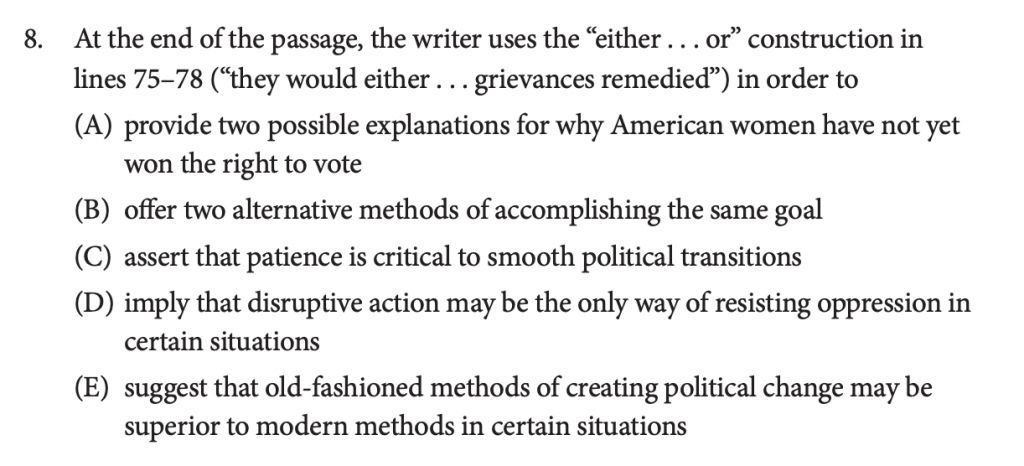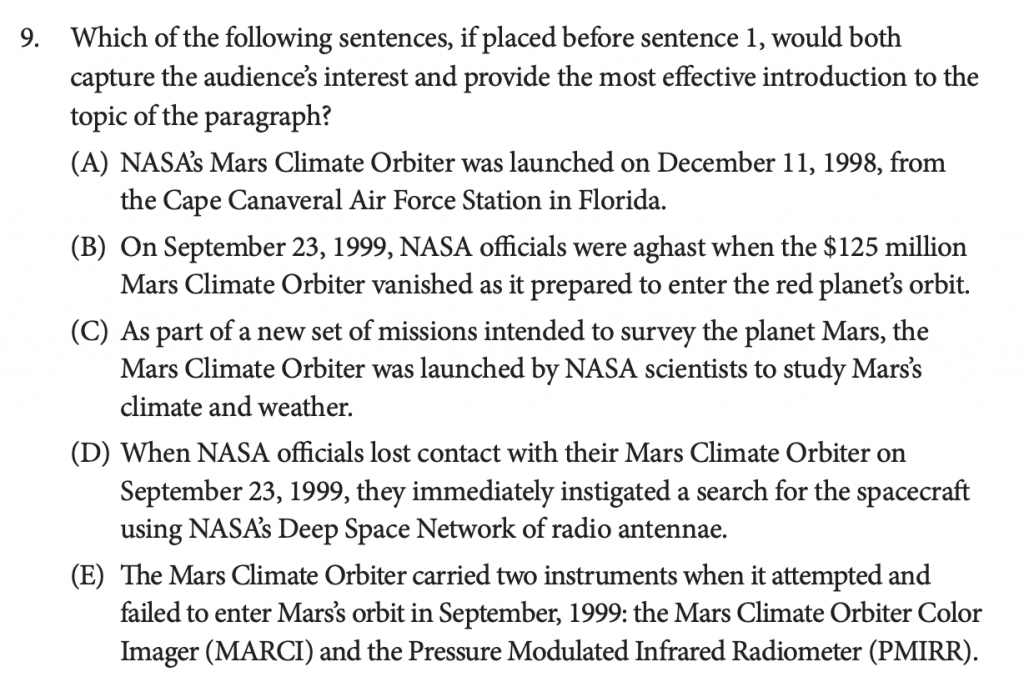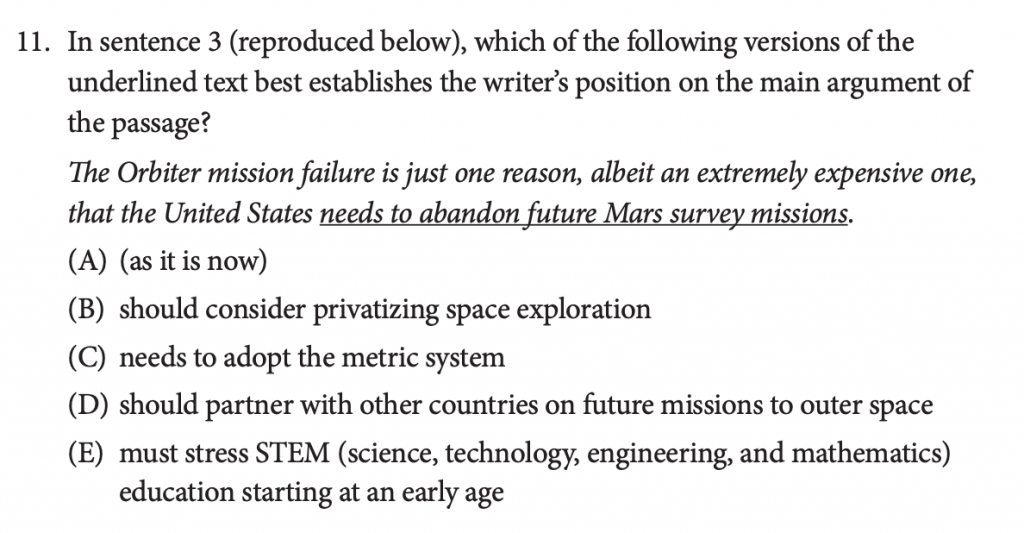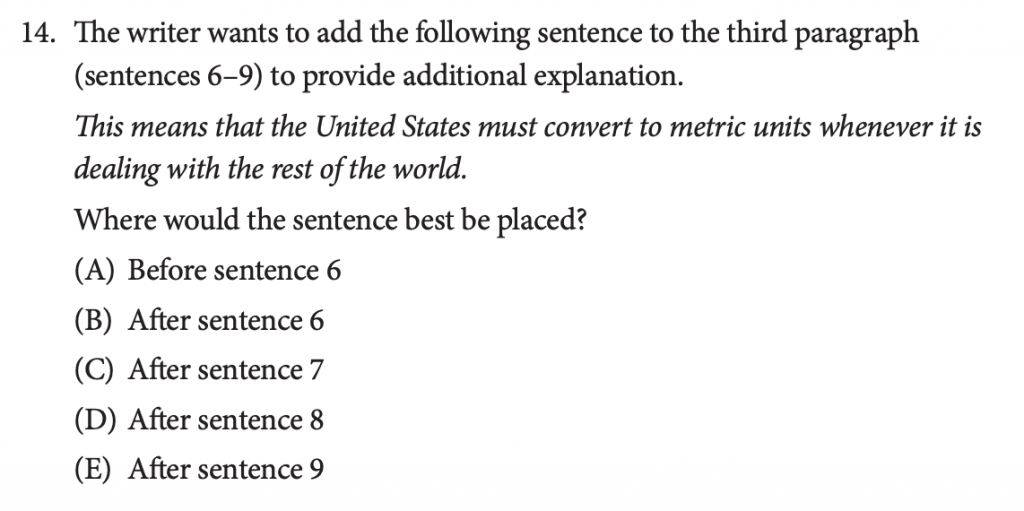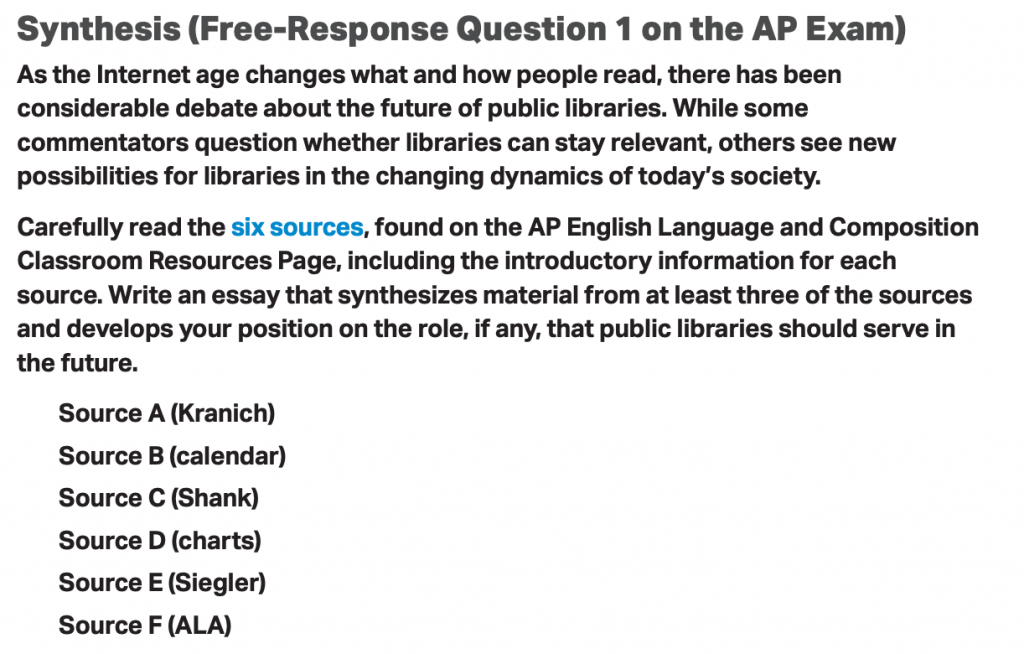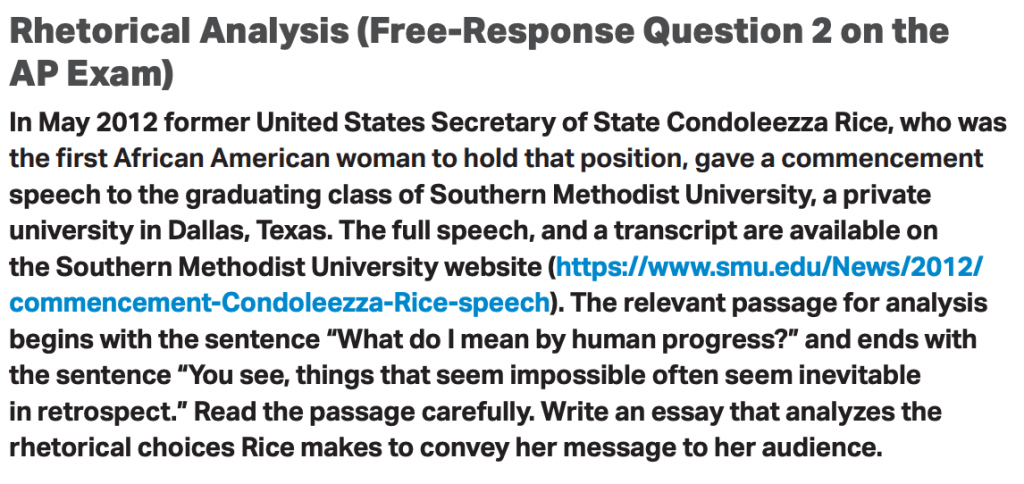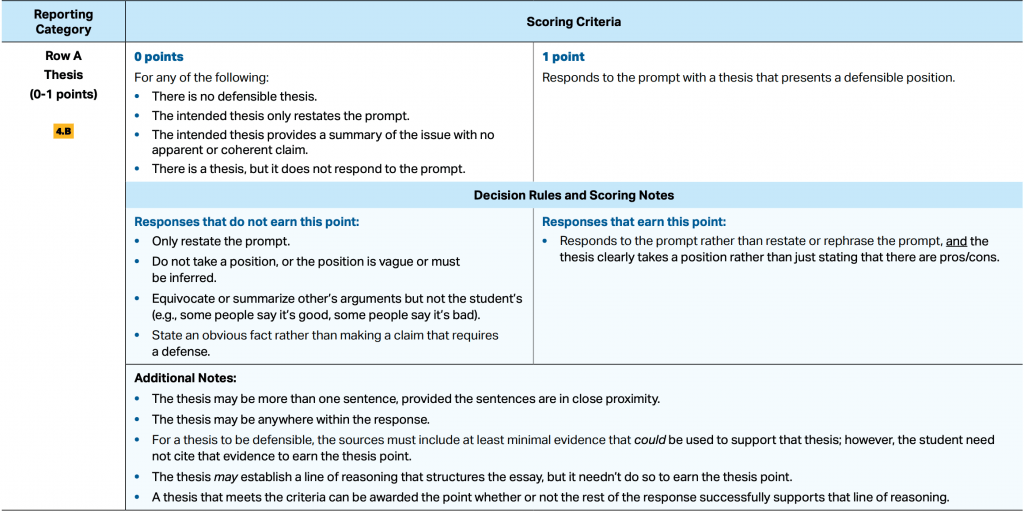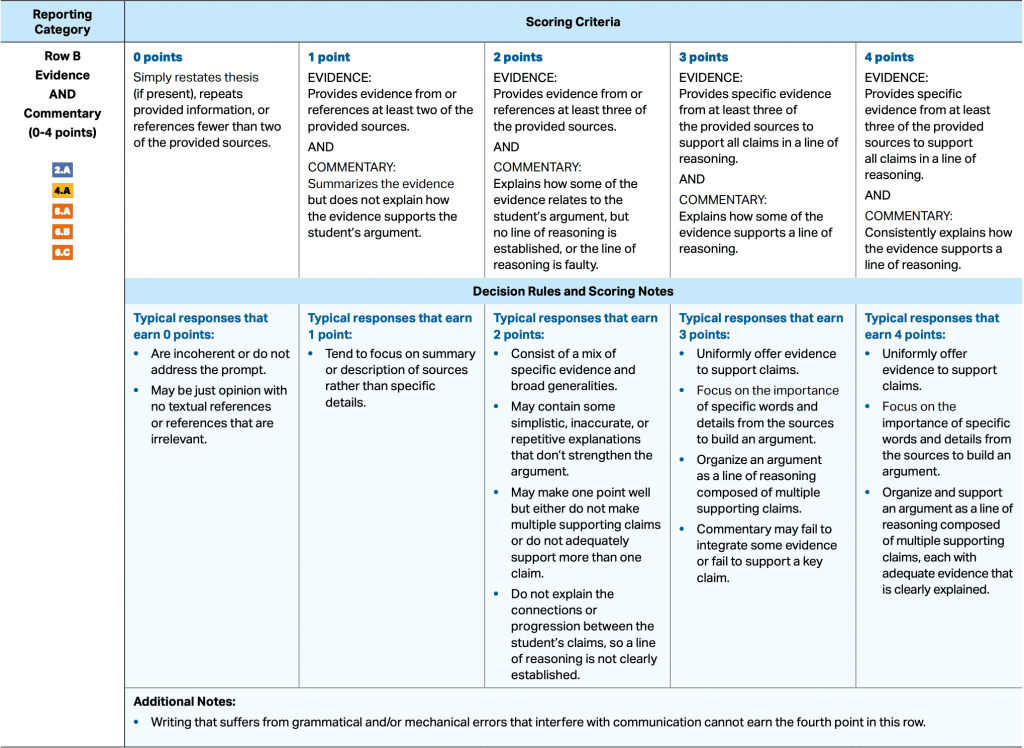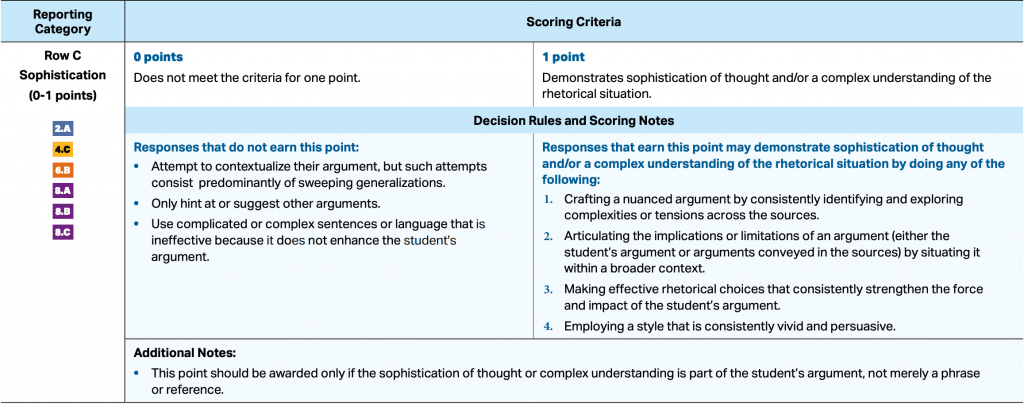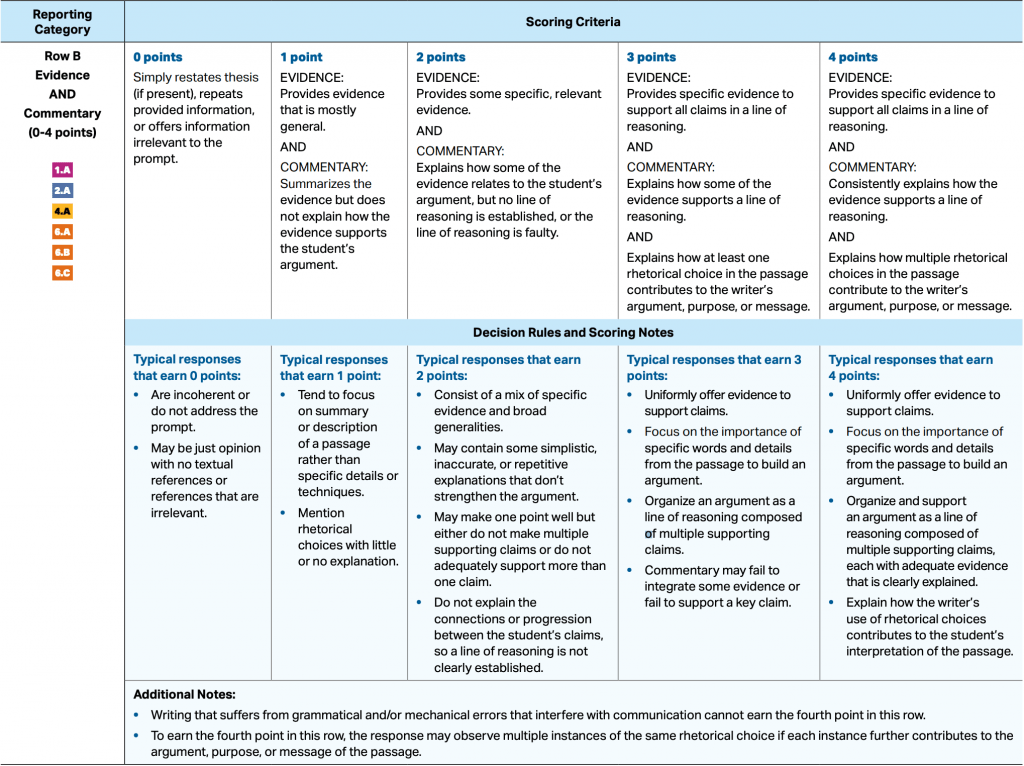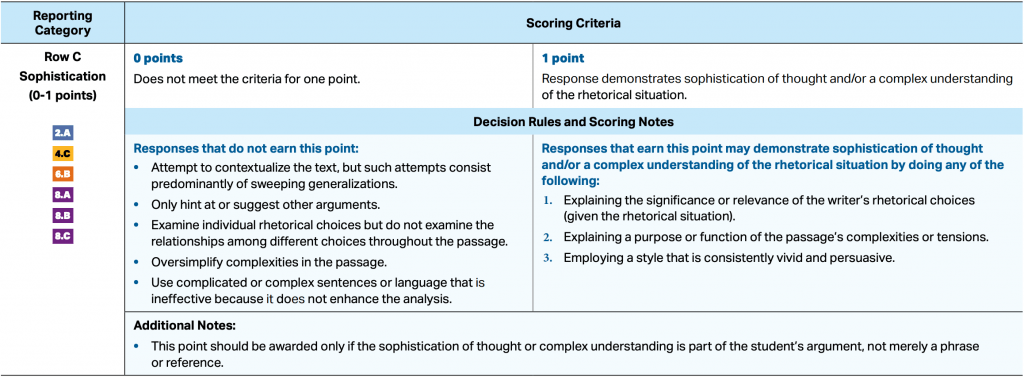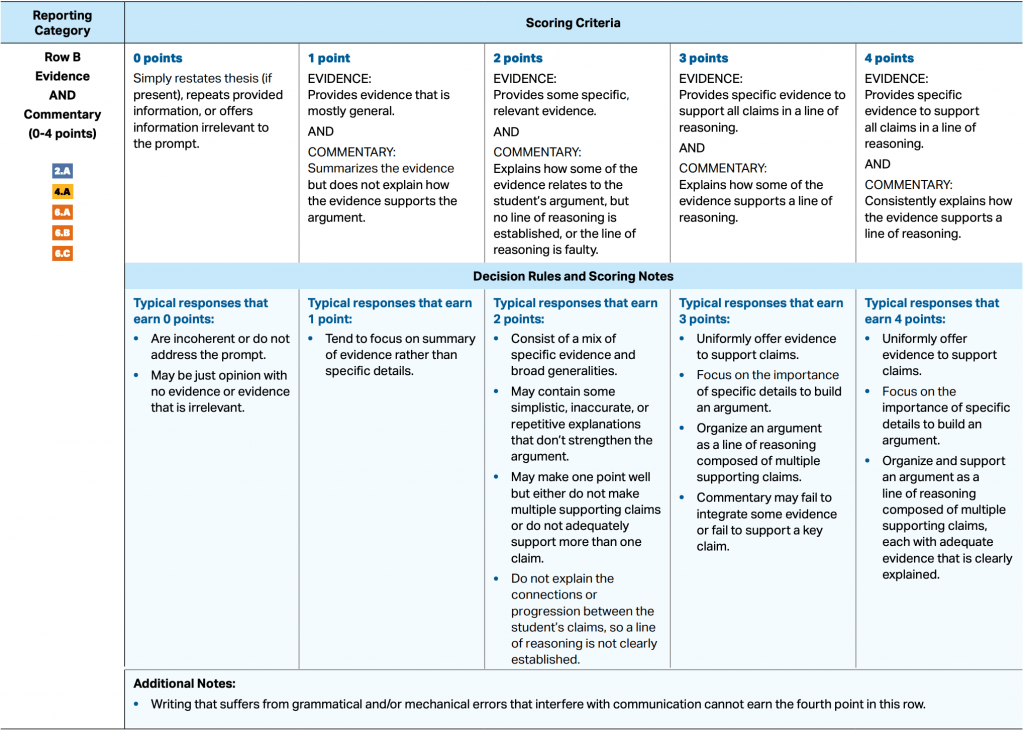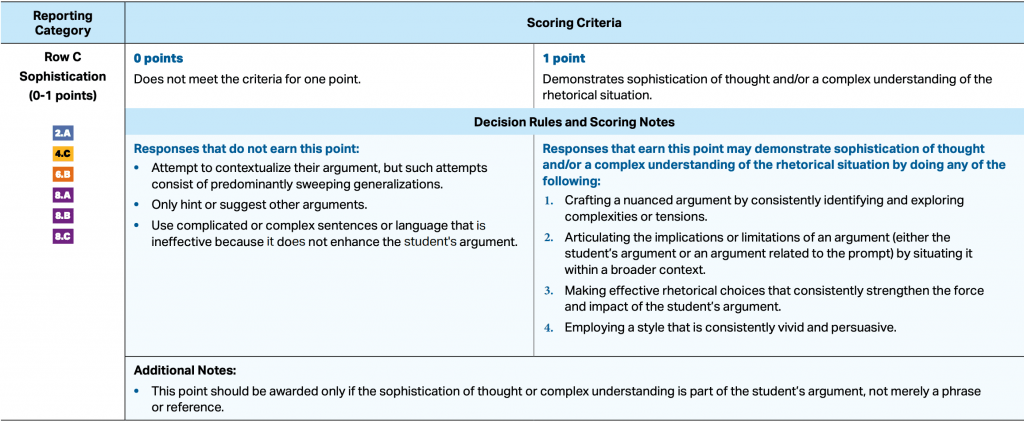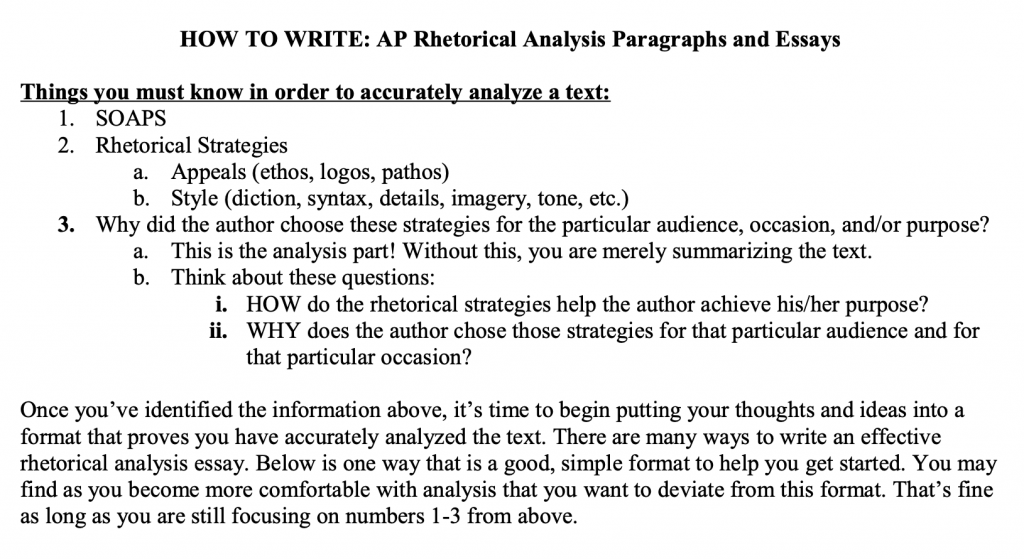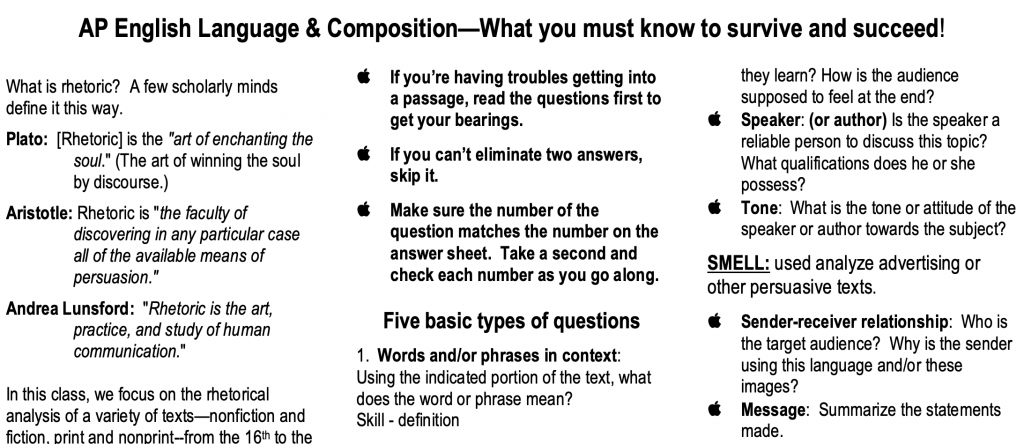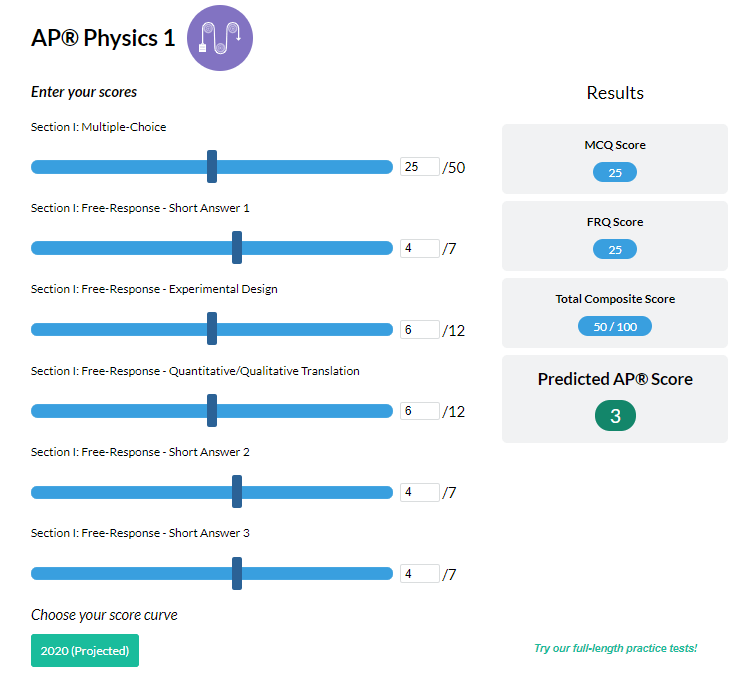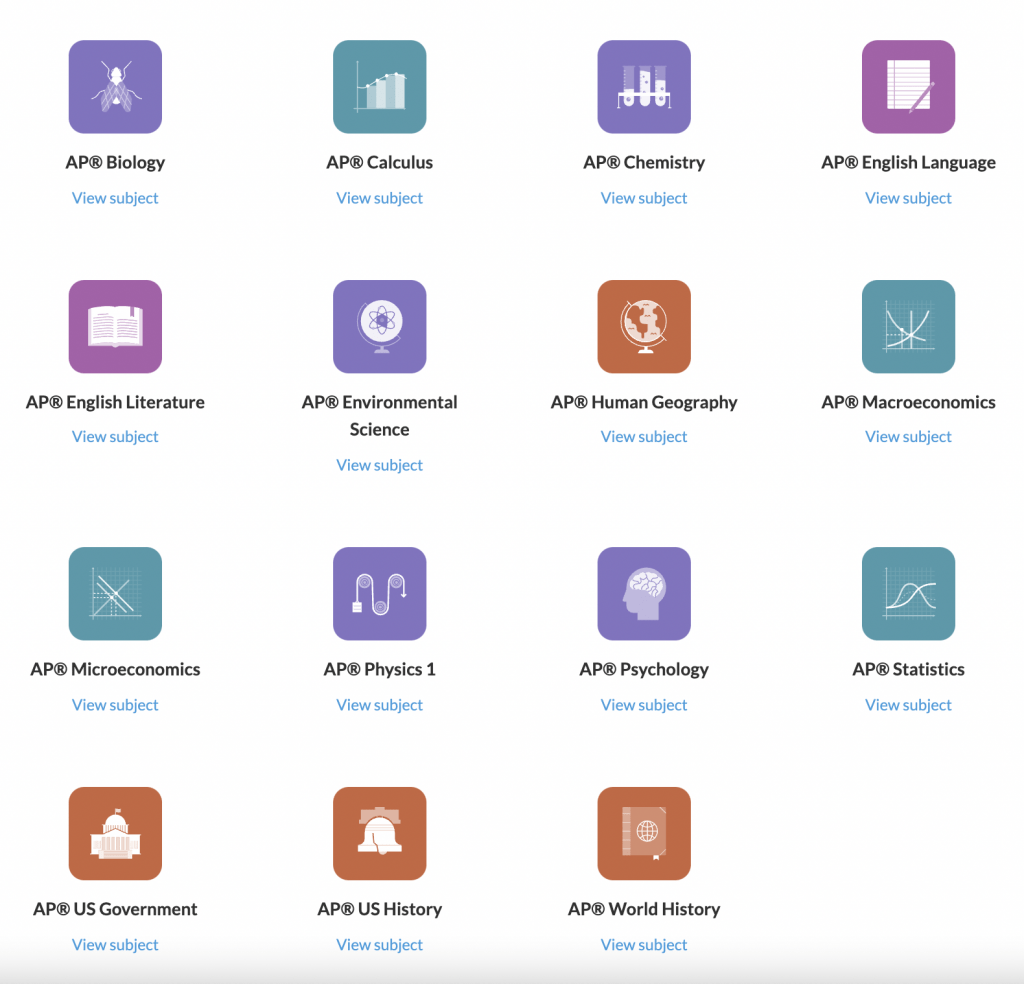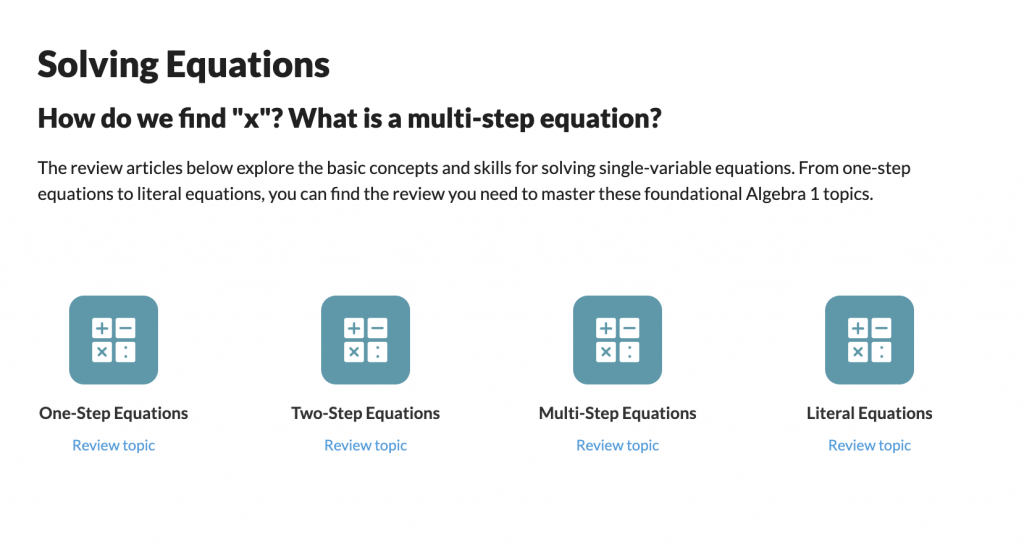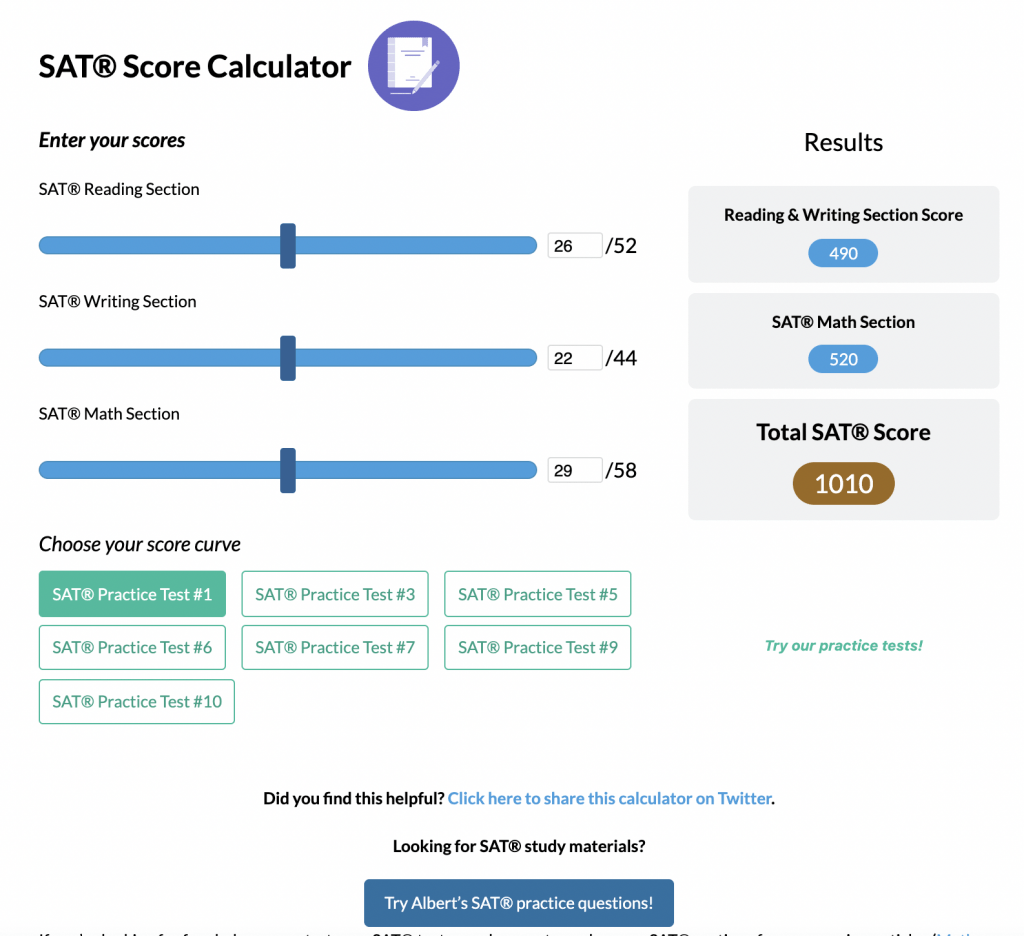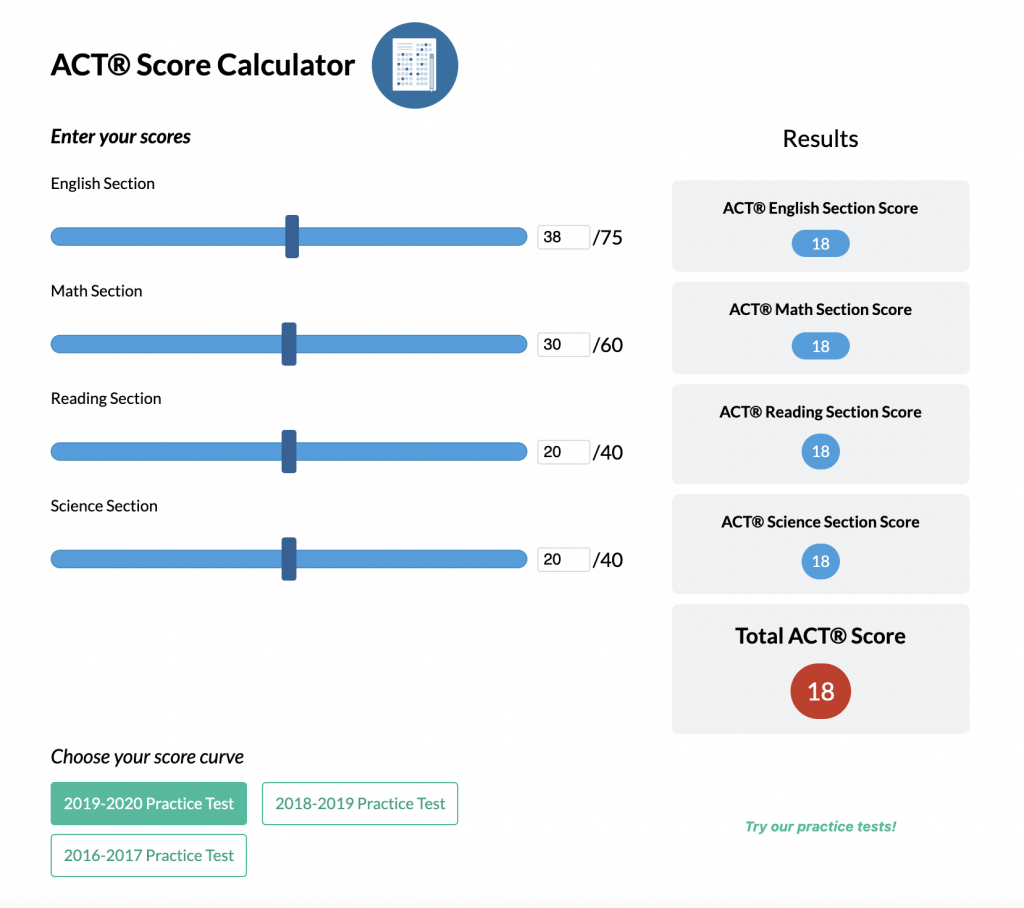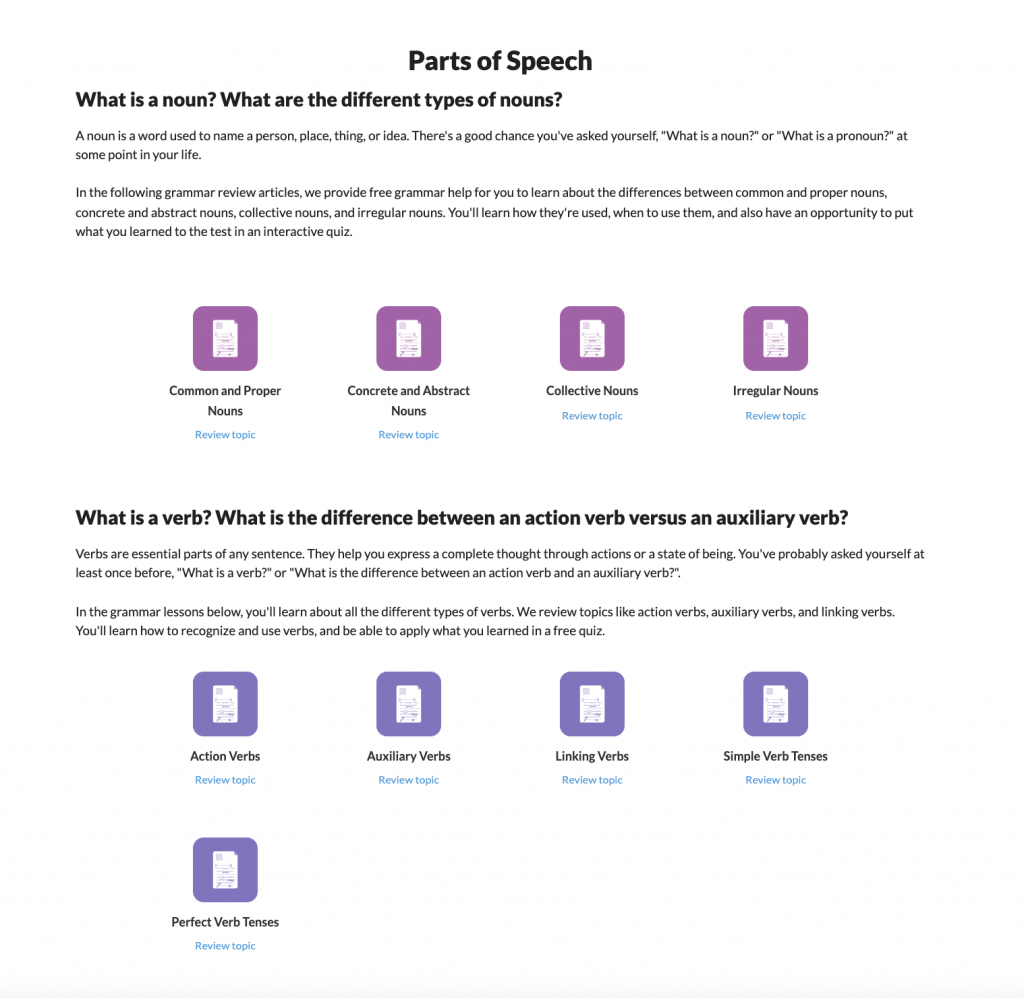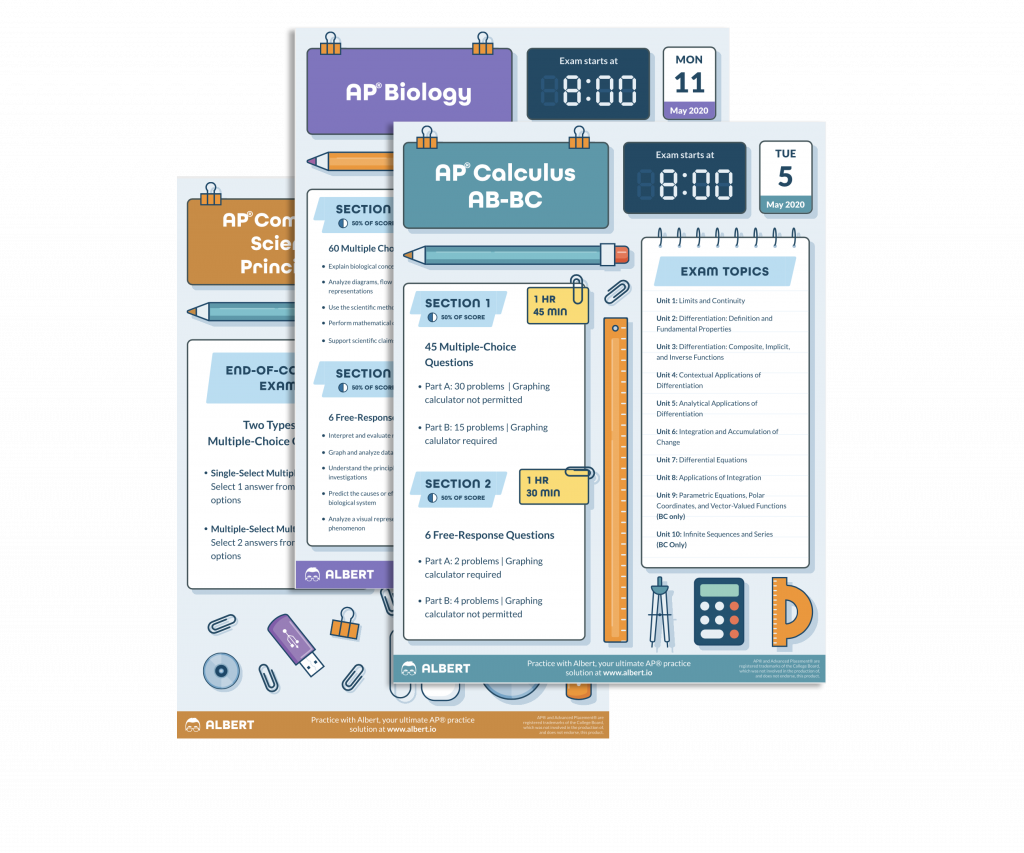Navigating the AP® English Language exam is tough. That’s why we wrote this comprehensive AP® English Language study guide.
In this post, we’ll go over key questions you may have about the exam, how to study for AP® English Language, as well as what review notes and practice resources to use as you begin preparing for your exam.
Are you ready? Let’s get started.
What We Review
What’s the Format of the AP® English Language and Composition Exam?
The AP® English Language and Composition exam is broken into two sections: multiple-choice and free-response.
Students are asked to complete 23-25 reading questions focused on rhetorical analysis and 20-22 writing questions focused on making revisions related to diction, syntax, and other grammar concepts. The number of free-response questions remains the same, but they are now scored using an analytic rubric rather than a holistic rubric.
| Section | Time Limit | # of Questions | % of Overall Score |
| I: Multiple Choice | 1 hour | 45 | 45% |
| II: Free Response | 2 hours 15 minutes | 3 | 55% |
How Long is the AP® English Language and Composition Exam?
The AP® English Language and Composition exam is 3 hours and 15 minutes long. Students will have 1 hour to complete the multiple-choice section (45 questions) and 2 hours and 15 minutes to complete the free-response section (3 questions).
How Many Questions Does the AP® English Language and Composition Exam Have?
Section I: Multiple Choice
- 5 passages total: 2 Reading and 3 Writing
- 23–25 Reading questions
- 20–22 Writing questions
Section II: Free Response
- 1 Synthesis question
- 1 Rhetorical Analysis question
- 1 Argument question
Return to the Table of Contents
What Topics are Covered on the AP® English Language and Composition Exam?
There are two types of AP® English Language and Composition questions: multiple-choice and free-response.
Section I: Multiple Choice
Because AP® English Language and Composition is a skills-based course, there’s no way to know what specific passages or topics might make it onto the official exam.
However, we know exactly which skills will be assessed with which passages, so it’s best to center your studying around brushing up on those skills! The charts below will help you understand which skills you should focus on.
| Set | # of Questions in Each Set | Skills Assessed |
| 1 | 11-14 | Reading skills 1, 3, 5, 7 |
| 2 | 11-14 | Reading skills 1, 3, 5, 7 |
| 3 | 7-9 | Writing skills 2, 4, 6, 8 |
| 4 | 7-9 | Writing skills 2, 4, 6, 8 |
| 5 | 4-6 | Writing skills 2, 4, 6, 8 |
Note that, even though there are more writing passages, reading passages have a greater total number of questions.
| Skill Category | Exam Weighting |
| 1. Rhetorical Situation — Reading (1.A, 1.B) | 11-14% |
| 2. Rhetorical Situation — Writing (2.A, 2.B) | 11-14% |
| 3. Claims and Evidence — Reading (3.A, 3.B, 3.C) | 13-16% |
| 4. Claims and Evidence — Writing (4.A, 4.B, 4.C) | 11-14% |
| 5. Reasoning and Organization — Reading (5.A, 5.B, 5.C) | 13-16% |
| 6. Reasoning and Organization — Writing (6.A, 6.B, 6.C) | 11-14% |
| 7. Style — Reading (7.A, 7.B, 7.C) | 11-14% |
| 8. Style — Writing (8.A, 8.B, 8.C) | 11-14% |
Section II: Free Response
Like the multiple choice section, the free response section is also skills-based. We cannot predict what specific passages you will be asked to analyze, but we do know the type of essays you will be asked to produce:
- 1 Synthesis essay: After reading 6-7 sources, students are asked to write an essay using at least 3 of the provided sources to support their thesis.
- 1 Rhetorical Analysis essay: Students read a non-fiction text and write an essay that analyzes the writer’s choices and how they contribute to the meaning and purpose of the text.
- 1 Argument essay: Students are given an open-ended topic and asked to write an evidence-based argumentative essay in response to the topic.
Return to the Table of Contents
What do the AP® English Language and Composition Exam Questions Look Like?
Multiple Choice Examples
The Course and Exam Description (CED) for AP® English Language provides 8 practice questions that address reading skills and 9 practice questions that address writing skills.
Below, we’ll look at examples of each question type and the skills and essential knowledge they address.
Skill: 1.A Identify and describe components of the rhetorical situation: the exigence, audience, writer, purpose, context, and message.
Essential Knowledge: RHS-1.B The exigence is the part of a rhetorical situation that inspires, stimulates, provokes, or prompts writers to create a text.
Skill: 3.A Identify and explain claims and evidence within an argument.
Essential Knowledge: CLE-1.A Writers convey their positions through one or more claims that require a defense.
Skill: 5.C Recognize and explain the use of methods of development to accomplish a purpose.
Essential Knowledge: REO-1.J When developing ideas through cause-effect, writers present a cause, assert effects or consequences of that cause, or present a series of causes and the subsequent effect(s).
Skill: 7.B Explain how writers create, combine, and place independent and dependent clauses to show relationships between and among ideas.
Essential Knowledge: STL-1.L The arrangement of clauses, phrases, and words in a sentence can emphasize ideas.
Skill: 2.A Write introductions and conclusions appropriate to the purpose and context of the rhetorical situation.
Essential Knowledge: RHS-1.I The introduction of an argument introduces the subject and/ or writer of the argument to the audience. An introduction may present the argument’s thesis. An introduction may orient, engage, and/or focus the audience by presenting quotations, intriguing statements, anecdotes, questions, statistics, data, contextualized information, or a scenario.
Skill: 4.B Write a thesis statement that requires proof or defense and that may preview the structure of the argument.
Essential Knowledge: CLE-1.I A thesis is the main, overarching claim a writer is seeking to defend or prove by using reasoning supported by evidence.
Skill: 6.A Develop a line of reasoning and commentary that explains it throughout an argument.
Essential Knowledge: REO-1.D Commentary explains the significance and relevance of evidence in relation to the line of reasoning.
Return to the Table of Contents
Free Response Examples
The Course and Exam Description (CED) for AP® Lang also provides a sample question for each FRQ. Below, we’ll review these examples and which skills they address.
Synthesis
Skills: 2.A, 4.A, 4.B, 4.C, 6.A, 6.B, 6.C, 8.A, 8.B, 8.C
This prompt is long, but it’s important to notice the key task:
- Write an essay that synthesizes material from at least three of the sources and develops your position on the role, if any, that public libraries should serve in the future.
So, your response should:
- Synthesize the material from at least three sources
- Make your position on the topic clear
In a bit, we’ll have a look at the rubric and see this in action.
Rhetorical Analysis
Skills: 1.A, 2.A, 4.A, 4.B, 4.C, 6.A, 6.B, 6.C, 8.A, 8.B, 8.C
The key task in this prompt is to:
- Write an essay that analyzes the rhetorical choices Rice makes to convey her message to her audience.
So, your response should:
- Analyze the author’s rhetorical choices
- Connect those choices to the author’s message and how it’s conveyed to the audience
We’ll also have a look at this rubric and learn how these points can be earned.
Argument
Skills: 2.A, 4.A, 4.B, 4.C, 6.A, 6.B, 6.C, 8.A, 8.B, 8.C
The key task here is:
- Write an essay that argues your position on Jordan’s claim that “private wants” threaten national identity.
So, your response should:
- Make your position on the topic clear
- Use evidence to back up your position
We’ll break down this rubric in a bit.
Return to the Table of Contents
Free Response Rubric Breakdowns
With the 2020 redesign came new rubrics for the AP® Lang essay section. Previously, essays were scored using holistic rubrics, on a scale of 0-9. Starting with the 2019 exam, students’ essays will be graded with new analytic rubrics. Each essay is worth up to 6 points.
Switching to an analytic rubric from a holistic rubric can be tricky, especially if you’ve already taken another AP® English class and are used to the holistic version. But, the best thing about an analytic rubric is that it tells you exactly what to include in your essay to earn maximum points.
Think of the new rubrics as a How To Guide to getting a 6 on each essay. Below, we’ll spend some time breaking down each element of each rubric, but first let’s take a look at the Thesis point, which is pretty similar across all 3 essays.
Row A: Thesis
The Thesis row is all or nothing — you either earn the point or you don’t. It’s important to learn the wording of the rubric to make sure you are crafting an AP-level thesis. Note that you will not earn the point if your thesis:
- Just restates the prompt
- Summarizes the issue without also making a claim
- Doesn’t respond to the prompt
That’s all pretty straightforward, but earning the point for this category is a little more tricky than it seems at first. You will earn the point if your thesis:
- Responds to the prompt with a defensible position
- Takes a clear position that does not simply state there are pros and cons to the issue
Notice the second point above. While you may want to include a counterargument in the body of your essay (more on this later), your thesis is not the place to do so.
The purpose of presenting a counterargument is to refute it then and make your own argument stronger. Presenting the opposing argument in your thesis gets confusing for a reader and can make it seem like you aren’t holding strong in your own position, so it’s best to save that for the body of your essay.
The Additional Notes section of the rubric is also important to understand. This details what may or may not earn the thesis point. The main takeaways here are:
- Your thesis may be more than one sentence, as long as those sentences are near one another
- Your thesis doesn’t have to be in your opening paragraph
- Your sources must support your thesis, but you do not necessarily need to cite them
- Your thesis doesn’t have to outline your argument
- Your thesis statement can earn the point independent of whether or not your essay supports it on the whole
The Synthesis Rubric
As we’ve already discussed, the synthesis essay is the first of the three. You will be presented with 6-7 sources related to a given topic and asked to write an essay using at least 3 of those sources to support your thesis.
Let’s take a look at the various elements of the rubric and how you can earn maximum points for each category.
Row B: Evidence and Commentary
The Evidence and Commentary row is a little more flexible than the Thesis row. You can earn between 0 and 4 points depending on the quality of the evidence and commentary that you provide. Note you will not earn any points if your evidence and commentary:
- Does nothing more than restate your thesis
- Repeats already given information
- References fewer than 2 of the sources
- Is just opinion without any textual evidence
The nice thing about this section is that there are lots of places you can earn points! You will earn full points if your evidence and commentary:
- Contains specific evidence from at least 3 of the sources
- Fully supports your claim and line of reasoning
- Explains how the evidence supports your claim and line of reasoning
- Pulls specific words or details from the sources that support your argument
- Supports a line of reasoning that is broken down into supporting claims, with each supporting claim supported by its own pieces of evidence
The final point in the above list is the main difference between earning full points and partial points in this section. AP-level evidence and commentary will not only support your overall claim, but will also support your supporting claims fully.
You can think of supporting claims as each individual body paragraph’s focus. If each body paragraph makes a supporting claim, and that supporting claim is bolstered by specific supporting evidence, you are much more likely to earn the full 4 points here.
The Additional Notes section of the rubric is also important to understand. This gives extra detail on what may or may not earn the thesis point. The main takeaway here is that your argument must be free of grammatical and/or mechanical errors in order to earn full points. This means that if your grammar is not solid, you can only ever earn 3 or fewer points in this section.
If you struggle with grammar or syntax, check out Albert’s Grammar course to help build up those skills!
Row C: Sophistication
Similar to the Thesis point, the Sophistication row is also all or nothing — you either earn the point or you don’t.
Where the Sophistication point differs from the Thesis point is that it’s a bit more difficult to understand how to earn it! The rubric states that essays that earn the point “demonstrate sophistication of thought and/or a complex understanding of the rhetorical situation.”
In plain English, this means that you will not earn the point if your essay:
- Contains sweeping generalizations
- Only hints at other positions on the argument
- Uses complex sentences or language that doesn’t add anything to the argument
You will earn the point if your essay:
- Explores complexities or tensions between the provided sources, creating a more nuanced argument
- Acknowledges implications or limitations of your own argument through counterarguments
- Acknowledges implications or limitations of the sources’ arguments by situating them within the broader context of the argument
- Makes purposeful rhetorical choices that strengthen your argument
- Uses vivid and persuasive style
Note that you will not earn the point for this section if the items listed above are done in a single sentence or two. These elements must be present throughout your argument.
The Rhetorical Analysis Rubric
The rhetorical analysis essay is the second of the three. You will be presented with a non-fiction text and asked to write an essay that analyzes the writer’s choices and how they contribute to the meaning and purpose of the text.
Row B: Evidence and Commentary
The Evidence and Commentary row is a little more flexible than the Thesis row. You can earn between 0 and 4 points depending on the quality of the evidence and commentary that you provide. Note you will not earn any points if your evidence and commentary:
- Does nothing more than restate your thesis
- Repeats already given information
- Gives information irrelevant to the prompt
- Is just opinion without any textual evidence
The nice thing about this section is that there are lots of places you can earn points! You will earn full points if your evidence and commentary:
- Explains how multiple rhetorical choices contribute to your understanding of the author’s argument, purpose, or message
- Fully supports your claim and line of reasoning
- Explains how the evidence supports your claim and line of reasoning
- Pulls specific words or details from the passage that support your argument
- Supports a line of reasoning that is broken down into supporting claims, with each supporting claim supported by its own pieces of evidence
The final point in the above list is the main difference between earning full points and partial points in this section. AP-level evidence and commentary will not only support your overall claim, but will also support your supporting claims fully.
You can think of supporting claims as each individual body paragraph’s focus. If each body paragraph makes a supporting claim, and that supporting claim is bolstered by specific supporting evidence, you are much more likely to earn the full 4 points here.
The Additional Notes section of the rubric is also important to understand. This gives extra detail on what may or may not earn the thesis point. The main takeaways here are:
- You may address the same rhetorical choice more than once, as long you are addressing different instances of it.
- Your argument must be free of grammatical and/or mechanical errors in order to earn full points. This means that if your grammar is not solid, you can only ever earn 3 or fewer points in this section. If you struggle with grammar or syntax, check out Albert’s Grammar course to help build up those skills!
Row C: Sophistication
Similar to the Thesis point, the Sophistication row is also all or nothing — you either earn the point or you don’t.
Where the Sophistication point differs from the Thesis point is that it’s a bit more difficult to understand how to earn it! The rubric states that essays that earn the point “demonstrate sophistication of thought and/or a complex understanding of the rhetorical situation.”
In plain English, this means that you will not earn the point if your essay:
- Contains sweeping generalizations
- Only hints at other positions on the argument
- Analyze individual rhetorical choices made by the author without also examining the relationships between the choices throughout the passage
- Oversimplify the passage
- Uses complex sentences or language that doesn’t add anything to the argument
You will earn the point if your essay:
- Explains the significance of the writer’s rhetorical choices
- Explains the purpose or function of the complexities or tensions in the passage
- Makes purposeful rhetorical choices that strengthen your argument
- Uses vivid and persuasive style
Note that you will not earn the point for this section if the items listed above are done in a single sentence or two. These elements must be present throughout your argument.
The Argument Rubric
The argument essay is the last of the three. You will be given an open-ended topic and asked to write an evidence-based argumentative essay in response to the topic.
Row B: Evidence and Commentary
The Evidence and Commentary row is a little more flexible than the Thesis row. You can earn between 0 and 4 points depending on the quality of the evidence and commentary that you provide. Note you will not earn any points if your evidence and commentary:
- Does nothing more than restate your thesis
- Repeats already given information
- Gives information irrelevant to the prompt
- Is just opinion without any textual evidence
The final point above might be confusing at first glance. Giving your opinion is natural in an essay that literally asks for your opinion! But, the key is making sure to back up your opinion with evidence.
The nice thing about this section is that there are lots of places you can earn points! You will earn full points if your evidence and commentary:
- Fully supports your claim and line of reasoning
- Explains how the evidence supports your claim and line of reasoning
- Focuses on the importance of specific details to build your argument
- Supports a line of reasoning that is broken down into supporting claims, with each supporting claim supported by its own pieces of evidence
The final point in the above list is the main difference between earning full points and partial points in this section. AP-level evidence and commentary will not only support your overall claim, but will also support your supporting claims fully.
You can think of supporting claims as each individual body paragraph’s focus. If each body paragraph makes a supporting claim, and that supporting claim is bolstered by specific supporting evidence, you are much more likely to earn the full 4 points here.
The Additional Notes section of the rubric is also important to understand. This gives extra detail on what may or may not earn the thesis point. The main takeaway here is that your argument must be free of grammatical and/or mechanical errors in order to earn full points. This means that if your grammar is not solid, you can only ever earn 3 or fewer points in this section.
If you struggle with grammar or syntax, check out Albert’s Grammar course to help build up those skills!
Row C: Sophistication
Similar to the Thesis point, the Sophistication row is also all or nothing — you either earn the point or you don’t.
Where the Sophistication point differs from the Thesis point is that it’s a bit more difficult to understand how to earn it! The rubric states that essays that earn the point “demonstrate sophistication of thought and/or a complex understanding of the rhetorical situation.”
In plain English, this means that you will not earn the point if your essay:
- Contains sweeping generalizations
- Only hints at other positions on the argument
- Uses complex sentences or language that doesn’t add anything to the argument
You will earn the point if your essay:
- Explores complexities or tensions between the various elements of your argument, creating a more nuanced argument
- Acknowledges implications or limitations of your own argument through counter arguments
- Acknowledges implications or limitations of the prompt’s argument by situating it within a broader context
- Makes purposeful rhetorical choices that strengthen your argument
- Uses vivid and persuasive style
Note that you will not earn the point for this section if the items listed above are done in a single sentence or two. These elements must be present throughout your argument.
Return to the Table of Contents
What Can You Bring to the AP® English Language and Composition Exam?
The College Board is rather specific about what you can and cannot bring to an AP® exam. You are at risk of having your score not count if you do not carefully follow instructions. We recommend that you carefully review these guidelines and pack your bag the night before so that you do not have any additional stress on the morning of the exam.
What You Should Bring to Your AP® English Language Exam
If you’re taking the paper AP® English Language exam in-person at school, you should bring:
- At least 2 sharpened No. 2 pencils for completing the multiple choice section
- At least 2 pens with black or blue ink only. These are used to complete certain areas of your exam booklet covers and to write your free-response questions. The College Board is very clear that pens should be black or blue ink only, so be sure to double-check!
- If you are concerned that your exam room may not have an easily visible clock, you are allowed to wear a watch as long as it does not have internet access, does not beep or make any other noise, and does not have an alarm.
- If you do not attend the school where you are taking an exam, you must bring a government issued or school issued photo ID.
- If you receive any testing accommodations, be sure that you bring your College Board SSD Accommodations Letter.
What You Should NOT Bring to Your AP® English Language Exam
If you’re taking the paper AP® English Language exam in-person at school, you should not bring:
- Electronic devices. Phones, smartwatches, tablets, and/or any other electronic devices are expressly prohibited both in the exam room and break areas.
- Books, dictionaries, highlighters, or notes
- Mechanical pencils, colored pencils, or pens that do not have black/blue ink
- Your own scratch paper
- Reference guides
- Watches that beep or have alarms
- Food or drink
This list is not exhaustive. Please check with your teacher or testing site to make sure that you are not bringing any additional prohibited items.
Return to the Table of Contents
How to Study for AP® English Language and Composition: 7 Steps
Start with a diagnostic test. Ask your teacher if they can assign you one of our full-length practice tests as a jumping-off point. Your multiple choice will be graded for you, and you can self-score your FRQs using the College Board’s scoring guidelines. If you would prefer to take a pencil and paper test, Princeton Review or Barron’s are two reputable places to start. Be sure to record your score.
Once you’ve completed and scored your diagnostic, it’s time to put the results to work and create a study plan.
- If you used Albert, you’ll notice that each question is labeled with the skill that it assesses. If any skills stand out as something you’re consistently getting wrong, those concepts should be a big part of your study plan.
- If you used Princeton Review, Barron’s, or another paper test, do your best to sort your incorrect answers into the skill buckets.
The tables below sort each set of skills into groups based on their Enduring Understandings and Big Ideas.
Big Idea: RHETORICAL SITUATION (RHS)
ENDURING UNDERSTANDING: Individuals write within a particular situation and make strategic writing choices based on that situation.
| 1.A Identify and describe components of the rhetorical situation: the exigence, audience, writer, purpose, context, and message. |
| 1.B Explain how an argument demonstrates understanding of an audience’s beliefs, values, or needs. |
| 2.A Write introductions and conclusions appropriate to the purpose and context of the rhetorical situation. |
| 2.B Demonstrate an understanding of an audience’s beliefs, values, or needs. |
Big Idea: CLAIMS AND EVIDENCE (CLE)
ENDURING UNDERSTANDING: Writers make claims about subjects, rely on evidence that supports the reasoning that justifies the claim, and often acknowledge or respond to other, possibly opposing, arguments.
| 3.A Identify and explain claims and evidence within an argument. |
| 3.B Identify and describe the overarching thesis of an argument, and any indication it provides of the argument’s structure. |
| 3.C Explain ways claims are qualified through modifiers, counterarguments, and alternative perspectives. |
| 4.A Develop a paragraph that includes a claim and evidence supporting the claim. |
| 4.B Write a thesis statement that requires proof or defense and that may preview the structure of the argument. |
| 4.C Qualify a claim using modifiers, counterarguments, or alternative perspectives. |
Big Idea: REASONING AND ORGANIZATION (REO)
ENDURING UNDERSTANDING: Writers guide understanding of a text’s lines of reasoning and claims through that text’s organization and integration of evidence.
| 5.A Describe the line of reasoning and explain whether it supports an argument’s overarching thesis. |
| 5.B Explain how the organization of a text creates unity and coherence and reflects a line of reasoning. |
| 5.C Recognize and explain the use of methods of development to accomplish a purpose. |
| 6.A Develop a line of reasoning and commentary that explains it throughout an argument. |
| 6.B Use transitional elements to guide the reader through the line of reasoning of an argument. |
| 6.C Use appropriate methods of development to advance an argument. |
Big Idea: STYLE (STL)
ENDURING UNDERSTANDING: The rhetorical situation informs the strategic stylistic choices that writers make.
| 7.A Explain how word choice, comparisons, and syntax contribute to the specific tone or style of a text. |
| 7.B Explain how writers create, combine, and place independent and dependent clauses to show relationships between and among ideas. |
| 7.C Explain how grammar and mechanics contribute to the clarity and effectiveness of an argument. |
| 8.A Strategically use words, comparisons, and syntax to convey a specific tone or style in an argument. |
| 8.B Write sentences that clearly convey ideas and arguments. |
| 8.C Use established conventions of grammar and mechanics to communicate clearly and effectively |
Once your list of practice questions is complete, check out our 5 AP® English Language and Composition Multiple Choice Study Tips for some pointers.
Now that you’ve got your multiple-choice study plan in place, it’s time to make a plan for the FRQs. You should have self-scored your essays using the College Board’s scoring guidelines. If you notice that there is one particular prompt you struggled with, use Albert’s AP® Lang FRQ prompts for more practice!
If you didn’t struggle with a particular prompt as much as you did a particular part of the rubric, try to figure out where you went wrong. Does your thesis restate the prompt instead of proposing your own position? Did you remember to provide evidence but forget to bolster it with commentary? Maybe your word choice wasn’t varied enough to earn the sophistication point. Whatever element you struggled with, have a look at our 5 AP® English Language and Composition FRQ Study Tips for some expert advice.
Once you’ve compiled your entire study plan using the link above and identified the skills you need to practice, it’s time to implement your plan! Check your calendar. How many days, weeks, or months do you have until your exam? Pace your studying according to this time frame. Pro-tip: If you only have a few weeks or days to go, prioritize the skills that you scored the lowest on.
About halfway through your study schedule, plan to take a second diagnostic test to check your progress. You can either have your teacher assign another full-length Albert practice test or use one of the additional practice tests included in whatever AP® English Language and Composition review book you purchased. Use these results to inform the rest of your study schedule. Are there skills that you improved on or scored lower on this time? Adjust accordingly, and use our tips in the next section to guide you.
Return to the Table of Contents
AP® English Language and Composition Review: 15 Must-Know Study Tips
Like anything else, learning to read and write at the AP® level takes time and practice. Whether this is the first AP® class you’ve taken or you’re just looking to brush up on your study skills, this list of tips will put you in a position to earn a passing score in May.
5 AP® English Language and Composition Study Tips for Home
1. Read. Read widely. Read constantly. Read everything.
There’s no substitute for reading. Reading has a number of benefits: a more impressive vocabulary, a better understanding of varied sentence structure and syntax, facility analyzing how and why authors make specific rhetorical choices. The more you read, the better equipped you will be to ace this exam.
2. Flashcards are your friend.
You will need to have a strong understanding of literary devices and rhetorical techniques, and you don’t want to waste time scrambling for definitions on exam day. Make yourself some flashcards with the most common literary devices and rhetorical techniques, and don’t forget to include grammar and punctuation there too. After all, a writer’s use of grammar and punctuation has as much impact on their prose as the words they use!
3. Take your homework assignments seriously, especially summer assignments.
Your teacher didn’t ask you to read that book for no good reason, or to write that essay just because! Summer assignments help to ensure that you are starting your school year off on the right foot. Every time that you complete a homework assignment, you are one step closer to earning a passing score on your exam. “Practice makes perfect” is a well-known phrase for a reason!
4. Seek out extra opportunities for practice!
Many practice books are available for purchase, and sometimes you can even find e-book versions to check out from your local library. Princeton Review and Barron’s are the most popular, but tons more can be found with a simple Google search.
5. Study with your friends!
Studying alone can sometimes be monotonous, and you might not have a lot of motivation if the only person holding you accountable is you. Forming study groups with friends and classmates ensures that you are held accountable, and it never hurts to have multiple perspectives on an essay question or multiple-choice answer. Plus, it’s just plain more fun.
5 AP® English Language and Composition Multiple Choice Study Tips
1. Practice answering multiple-choice questions as often as you can.
AP® English Language and Composition multiple choice questions will fall into one of the following buckets: rhetorical situation, claims and evidence, reasoning and organization, and style. If these categories look familiar to you, that’s because these are also the four Big Ideas outlined in the AP® Lang CED.
2. Exercise your close-reading skills.
The true key to acing the multiple choice section of this exam is staying engaged with the passages provided to you and actively reading. Active reading looks different to different people, so find what works best for you! For some, this can mean annotating as they read the passage. For others, this can mean reading the passage more than once: the first time just to scan for important information, and the second time to gain a deeper understanding.
3. Look over the questions before reading the passage.
This tip doesn’t work for all readers, but it can be helpful if you’re someone who gets easily distracted when reading! If you find your mind wandering when reading AP® Lang passages, knowing the questions beforehand can give your brain a purpose to focus on.
4. Use process of elimination.
Typically, an AP® Lang multiple choice question will have one or two answer choices that can be crossed off pretty quickly. See if you can narrow yourself down to two possible answers, and then choose the best one. If this strategy isn’t working on a particularly difficult question, it’s perfectly okay to circle it, skip it, and come back to it at the end.
5. Remember that it doesn’t hurt to guess.
Guessing on every single question isn’t a good strategy, of course, but you are scored only on the number of correct answers you give, not the number of questions you answer.
5 AP® English Language and Composition FRQ Study Tips
1. Practice answering questions from The College Board’s archive of past exam questions.
Typically, the same skills are assessed from year to year, so practicing with released exams is a great way to brush up on your analysis skills.
2. Time yourself.
On test day, you are free to work on all three essays at your own pace so long as you finish within the 2-hour and 15-minute time frame. But, College Board directions recommend that you spend no longer than 40 minutes on each individual essay—not including the 15-minute reading period. So, while you’re practicing with the archive linked in Tip #1, be sure to have a timer handy!
3. Use the rubric!
The best part about the AP® English Language and Composition revised rubrics and scoring guidelines is that it’s very clear what elements are needed to earn full credit for your essay. Ensure that your thesis statement is clear and defensible; you provide specific evidence and commentary that supports your thesis; and you develop a clear and compelling argument.
4. Pay attention to the task verbs used in your FRQ prompts.
The College Board deliberately includes these to help you guide your response. Task verbs you’ll see on the exam are: analyze, argue your position, read, synthesize, and write. Further breakdown of each of these task verbs can be found at the bottom of this College Board Writing Study Skills list.
5. Know your rhetorical devices and techniques.
While you don’t need to call out these techniques and devices by name, you do need to know their purpose and effect on the passage. For example, maybe you know that the author is deliberately understating something for effect and to draw attention to something, but you can’t remember that the term for this is litotes. As long as you can successfully show this understatement’s effect on the overall piece and connect it back to your thesis, you’ll be okay.
Return to the Table of Contents
The AP® English Language and Composition Exam: 5 Test Day Tips to Remember
1. Get everything ready to go the night before.
Nobody wants to be scrambling around the morning of the exam with a million things left to do! Make sure you have everything from our What You Should Bring list in your backpack and ready to go.
2. Make sure you know where your testing site is and how to get there, especially if you’re taking the exam someplace other than your own school.
If you’re getting a ride from a parent or friend, be sure they know the address beforehand. If you’re taking public transit, check the schedule. Don’t get too comfortable if you are taking your exam at your own school. Be sure you know the room number! This is something small but impactful that you can do to reduce your stress the morning of your exam.
3. Be sure to eat.
We know, every teacher tells you this, but it’s for a good reason! If you’re hungry during the exam, it might be harder for you to focus, leading to a lower score or an incomplete exam. Making sure that you’ve eaten before taking your exam eliminates one less distraction, helping you stay focused and on task.
4. Bring mints or gum with you.
The rules say that you can’t have food or drink in the testing room, but mints and/or gum are usually allowed unless it’s against your testing site’s own rules. If you find yourself getting distracted, pop a mint in your mouth! This can help to keep you more awake and focused.
5. Breathe! Seriously, breathe.
If you’ve followed the rest of the tips in this post, listened to your teacher, and done your homework, you’re well-prepared for this exam. Trust that you have done all you can do to prepare and don’t cram the morning of. Last-minute studying helps no one!
Return to the Table of Contents
AP® English Language and Composition Review Notes and Practice Test Resources
Write Space

This site provides AP® Lang students and teachers with resources on rhetorical analysis, synthesis, argument, grammar support, and much much more to help guide you through the AP® English Language and Composition exam.
How to Guide for Rhetorical Analysis Essays
This step-by-step guide will take you through writing a rhetorical analysis essay from beginning to end.
AP® English Language and Composition Survival Guide
This survival guide is a one-stop-shop for everything you need to about multiple choice questions, essay writing, rhetorical terms, and more!
Ms. Effie’s Lifesavers

If you’re a seasoned AP® English teacher, Ms. Effie (Sandra Effinger) probably needs no introduction! Ms. Effie’s Lifesavers has helped many an AP® Lang (and Lit!) teacher plan effective and thoroughly aligned lessons and assignments. Sandra was an AP® Reader for many years, so she knows her stuff. She has tons of free content on her page, as well as a Dropbox full of AP® English goodies for anyone who makes a donation via her PayPal.
AP® Study Notes

This site has some great sample essays written at the AP® level. They also have a section dedicated to rhetorical terms, which is great if you want to make flashcards for review.
Return to the Table of Contents
Summary: The Best AP® English Language and Composition Review Guide
Remember, the structure of the AP® Lang exam is as follows:
| Section | Time Limit | # of Questions | % of Overall Score |
| I: Multiple Choice | 1 hour | 45 | 45% |
| II: Free Response | 2 hours 15 minutes | 3 | 55% |
Because AP® English Language and Composition is a skills-based course, there’s no way to know what specific passages or topics might make it onto the official exam. But, we do know exactly which skills will be assessed with which passages, so it’s best to center your studying around brushing up on those skills!
Start with a diagnostic test, either on Albert or with a pencil and paper test via Princeton Review or Barron’s. Once you’ve completed and scored your diagnostic, follow our 7 steps on how to create an AP® English Language and Composition study plan.
Read! The more you read, the better equipped you will be to ace this exam.
Practice answering multiple choice questions on Albert and free-response questions from The College Board’s archive of past exam questions.
If you’ve followed the rest of the tips in this post, listened to your teacher, and done your homework, you’re well-prepared for this exam. Trust that you have done all you can do to prepare and don’t cram the morning of. Last-minute studying helps no one!

